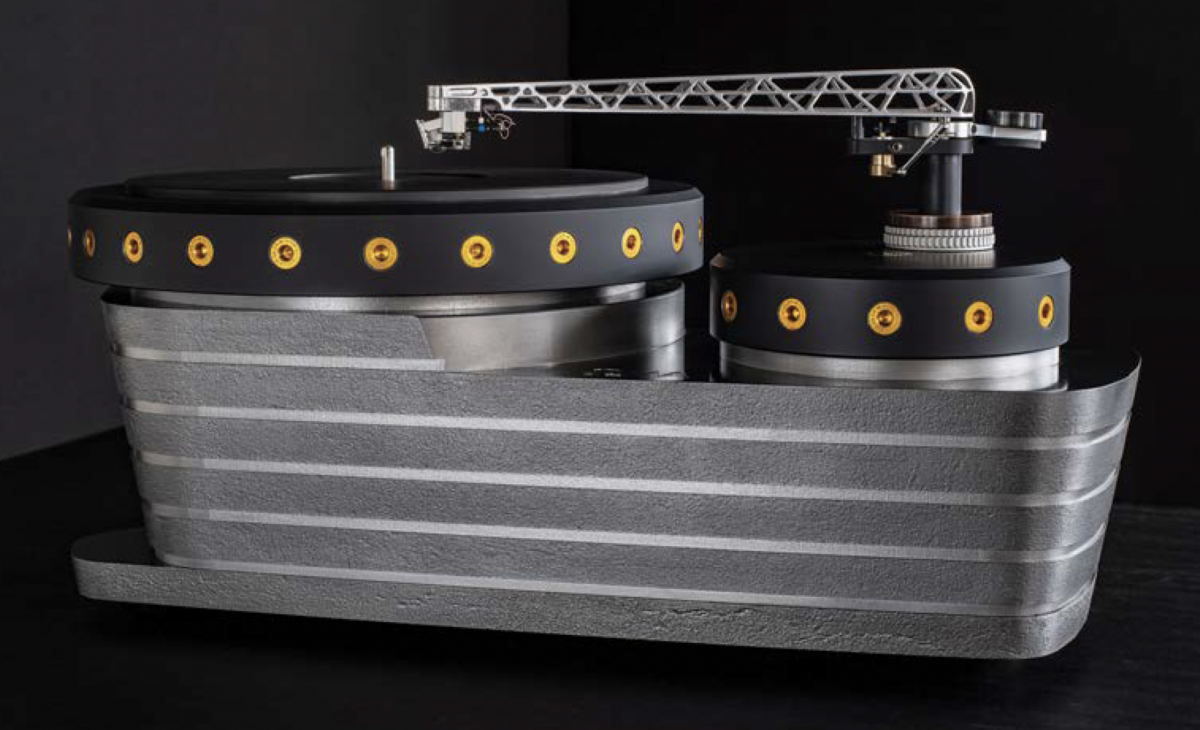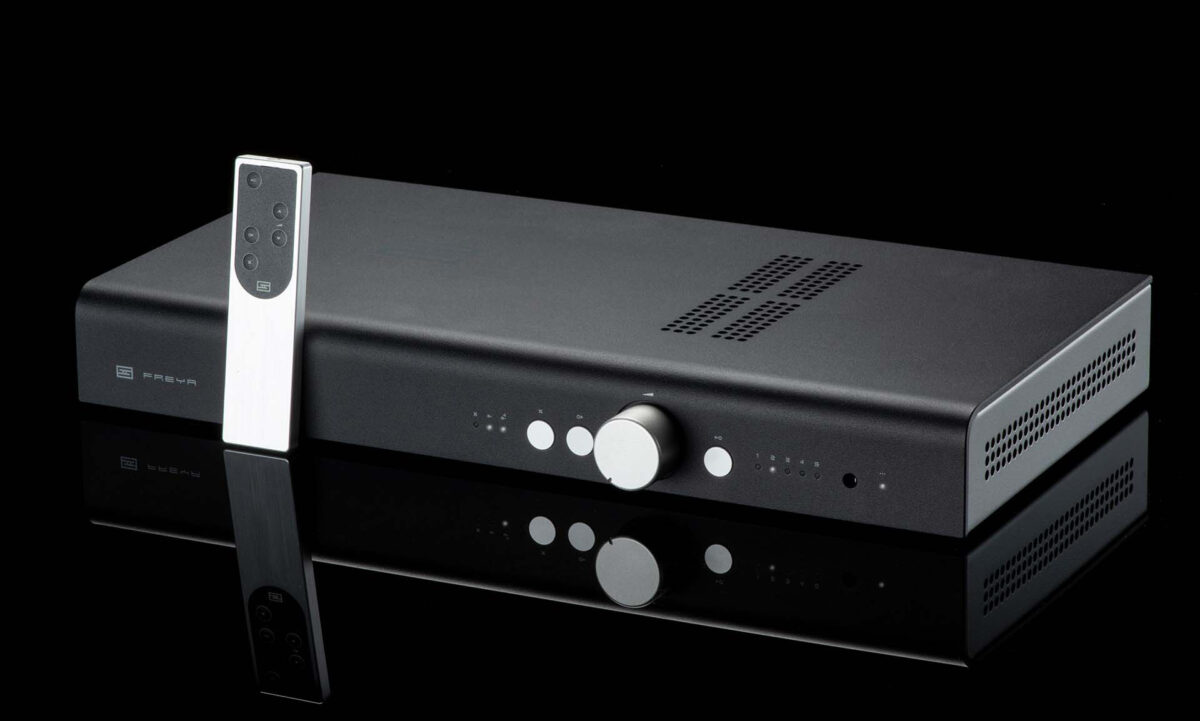
Mention the name Helmut Brinkmann to an audiophile and the first thing that comes to mind is probably the German designer’s superb turntables. But Brinkmann began his audio career more than 35 years ago making amplifiers, and even designed his first DAC way back in 1986 (called the “Zenith”). Now Brinkmann has come full circle with the new Nyquist DAC, a product that is designed and built with the same fanatical attention to detail as the company’s turntables. Moreover, the Nyquist is brimming with advanced features, including MQA decoding, high-speed DSD support, Roon-ready operation, UPnP connectivity, and upgradeable digital circuitry. Yet for all its cutting-edge digital prowess, the Nyquist’s output stage is built around that most ancient and venerable of audio technologies, the vacuum tube.
The product of a recently expanded digital-design team, the Nyquist is a three-component affair: the DAC itself, the 24-pound granite base on which it rests, and the outboard power supply. In Brinkmann tradition, the granite base isolates the DAC from vibration. Four vacuum tubes are mounted horizontally outside the chassis (two on each side), but encased in large fins that resemble heatsinks. The front panel offers three buttons, two knobs, a headphone jack, and a comprehensive display. The latter indicates the incoming signal’s format and sampling frequency, output level, and whether phase inversion has been engaged. The display also shows when the Nyquist is decoding an MQA file. A period after the MQA initialism indicates “MQA Studio” mode—files that have been auditioned and approved, in MQA format, by the artist, producer, or record-company representative. The left knob adjusts the analog output signal’s level (limited to a range of 10dB for the line output, but with a full range of level control when the headphone output is engaged), and the right knob selects the digital input. Volume, input select, and phase inversion are available on the supplied remote control. Balanced and unbalanced analog outputs are offered on the rear panel. The Nyquist is supplied with a Brinkmann-designed AC power cord. Brinkmann recommends connecting the AC cord directly to the wall outlet rather than through a power conditioner.
The Nyquist is fully up to date with the latest in streaming technology and connectivity. In addition to decoding any PCM sample rate up to 384kHz, it is DSD compatible all the way up to DSD256 (four times the standard DSD rate). An Ethernet port provides network connectivity, allowing you to stream music from any UPnP (Universal Plug ’n’ Play—some wags call it “Universal Plug ’n’ Pray”) device. Some NAS drives incorporate an integral UPnP server, which obviates the need for a PC or Mac. If you want to use a computer with the Nyquist, you can configure most music-playback software programs to operate as a UPnP server. The Nyquist is a Roon-certified endpoint, allowing you to stream from any Roon core server on the network to the Nyquist via Roon’s superb interface. The Nyquist supports Tidal, Deezer, and vTuner Internet Radio.

Brinkmann was one of the first companies to embrace MQA, the format for delivering high-resolution music via streaming services. MQA is much more than a convenient distribution system; the format fundamentally rethinks the entire digital encoding-transmission-decoding chain and employs radically new technology to overcome sonic and technical limitations inherent in traditional digital audio. It’s a bit ironic that the DAC is named after Harry Nyquist, the Bell Labs engineer who formulated, in the 1920s, many of the concepts upon which digital audio is based (including the famous “Nyquist Theorem” that states that a digital-encoding system’s sample frequency must be at least twice as high as the highest signal frequency to be sampled). I say it’s ironic because MQA overthrows some of Nyquist’s ideas in favor of a more sophisticated analysis. Fundamental “laws” of digital audio, once thought to be inviolable, have fallen in much the same way that Newtonian physics was upended by quantum mechanics.
Brinkmann is awfully proud of the Nyquist’s build-quality judging from the see-through top cover. Indeed, the layout, parts-quality, and design are exemplary—a model of meticulous engineering. The outboard power supply sends regulated DC to the Nyquist where it is further regulated next to the circuits supplied. The digital module alone incorporates 11 separate power-supply regulation stages.
The Nyquist is built around the ESS ES9018S Sabre DAC, one for each channel. Each 9018 DAC incorporates eight separate digital-to-analog converters; their outputs are combined to lower the noise floor, randomize any conversion errors, and create a balanced output signal. Brinkmann uses only the DAC portion of the Sabre chip, ignoring its integral PLL and upsampling digital filters. Rather than use these compromised sub-systems, the Nyquist has a separate Brinkmann-designed PLL and re-clocking circuit to reduce jitter. The clock is said to have very low phase noise, and is located right next to the DAC chip (the point where jitter matters). Similarly, the digital filter is implemented in a separate DSP chip running Brinkmann’s custom filter software. This filter upsamples all incoming PCM data to 352kHz or 384kHz for conversion to analog. Sources at 44.1kHz or multiples of that rate (88.2kHz, 176.4kHz) are upsampled to 352kHz; sources at 48kHz or multiples of that rate (96kHz or 192kHz) are upsampled to 384kHz. This dual-frequency scheme avoids sonically degrading non-integer upsampling. Interestingly, the 3.3V that supplies the ES9018S DAC chip is derived from the 160V rail that supplies the tubes. Brinkmann found that this supply technique improved the sound compared with powering the DAC chip from a conventional supply.
This description is of the signal path when decoding PCM sources. Commendably, the Nyquist features a completely independent signal path and data conversion for DSD signals. Unlike most DACs that convert DSD to PCM, the Nyquist features a dedicated DSD DAC. Moreover, this DAC is fully discrete and of Brinkmann’s own design rather than an off-the-shelf chip. The DSD signal path includes a very gentle analog output filter. I’ve heard only two DSD DACs with a discrete DSD converter (the Nyquist and the T+A PDP 3000 HV) and can say that they are significantly better sounding than chip-based converters.
The entire digital circuitry is housed in a module that can be removed by loosening screws on the bottom of the chassis and sliding the module out the rear panel. The module includes the digital inputs, PLL, digital filters, Ethernet streaming circuits, and DACs. Consequently, it is possible for Brinkmann to upgrade the digital section as technology changes while keeping the core performance platform of the power supply and analog output stage.
All of this cutting-edge digital technology feeds a vacuum-tube output stage. Each channel is built around a matched pair of NOS (new old stock) Telefunken PCF803 tubes. This unusual tube, developed in the 1960s for color television, contains one pentode and one triode in the same envelope. The PCF803 was designed to provide at least ten years of service, but the tube is operated more gently in the Nyquist than it would have been in a television. Brinkmann has secured a supply of the tube for replacement in the future. The only analog filtering after the DAC is a pair of Lundahl transformers, which must have a very gentle roll-off with a very high cut-off frequency compared with the typical analog filter found in other DACs.
Finally, the balanced headphone jack is driven by the tube output stage rather than by an IC amplifier outside the main signal path. Headphone listening thus benefits from the dual PCD/DSD signal paths as well as the tube output stage. The headphone output is activated, and the main output is muted, by pressing the “Headphone” button above the headphone jack.

It’s readily apparent that a lot of thought and effort went into creating the Nyquist. This is clearly a statement-level product. Helmut Brinkmann is known for his obsessive listening evaluations to every component in the product, including those that are apparently insignificant. Through this listening he’s discovered many sonically beneficial techniques, particularly in vibration isolation. The Nyquist is also beautifully executed, and it doesn’t hurt that Helmut Brinkmann personally inspects every product before it leaves the factory.
Listening
I heard a demonstration of a pre-production Nyquist at last year’s Munich at the front end of Vandersteen Model 7 Mk.II speakers. That room was, by general consensus, one of the best (if not the best) at Munich last year—which, given the level of gear on display throughout the show, is saying a lot. That demo, plus the Nyquist’s inclusion of MQA decoding, the tube output stage, and Brinkmann’s reputation all suggested that a full evaluation was in order.
Brinkmann calls the Nyquist an “analog digital-to-analog converter.” That may sound like an oxymoron, but it reflects Brinkmann’s design approach and intent. As it happens, that moniker also perfectly describes the Nyquist’s sound. In fact, “analog” is perhaps the best single word to illustrate the Nyquist. This is a DAC that, even with standard-resolution files, sounds very “un-digital.” All the qualities that analog is famous for—dimensionality, treble smoothness, bloom, timbral purity—were readily apparent, but coupled with digital’s strengths of image solidity, pitch stability, and bass impact. The Nyquist had a natural, almost relaxed, quality that I found deeply engaging. I would sit down with a notepad for a critical listening session to categorize the Nyquist’s strengths and shortcomings and find myself hours later without a single note—but feeling musically fulfilled.
A large part of why the Nyquist sounds so analog-like is in its reproduction of bloom, dimensionality, and what Jonathan Valin calls “action”—the elusive characteristic of air expanding and contracting around an instrumental image in response to that instrument’s dynamic changes. The Nyquist was the antithesis of flat, dry, sterile, and lacking in air. Instead, the soundstage was gloriously infused with a tangible space between instruments, with a puff of air around them. Digital has the tendency to starkly render images, with precise specificity and sharp outlines, but somehow fails to capture the ethereal component of three-dimensionality of both the soundstage and the images within it. Images lack body and roundness, sounding flat and dry. The whole thing has a “freeze-dried” character.
But the Nyquist transcends these common shortcomings, rendering images as fully fleshed-out three-dimensional objects surrounded by tangible air, much the way that great analog does. This was particularly true when the Nyquist was decoding MQA files; the format preserves these low-level cues and presents them in a completely natural way. The specific quality was appealing not in-and-of-itself, but because of the way it sounds more like real instruments in an acoustic space.
The bloom and dimensionality wasn’t just in the mids and treble, but also through the entire bass region. The bass was big, weighty, and full rather than taut and crisp. Pitch definition was excellent, but what really distinguished the bottom end was the sense that acoustic bass had a three-dimensional body and wasn’t a flat cardboard cutout. The stand-up bass on the Rhiannon Giddens track “That Lonesome Road” from the album Factory Girl, which has big and bloomy “washtub” sound that fits the tune, had a stunning sense of body, depth, weight, textural density, and power. The bass overall tended to be warm, rich, and generous—qualities that conveyed the physicality of the instrument. The densely textured bottom end, wonderful sense of three-dimensional bloom, and resolution of fine spatial detail was particularly beautiful on piano. The instrument’s solidity and warmth brought to the fore left-hand piano lines, particularly evident on Brad Mehldau’s unique phrasing and ability to explore a melody with both hands with equal intensity and technical virtuosity.
Speaking of piano, once you get used to hearing that instrument reproduced in the MQA format, conventional digital encoding’s distortions become painfully evident. MQA removes the “shattering” sound of hammers hitting strings in the upper register, reveals greater harmonic complexity, presents a larger space around the instrument, and resolves decays (and the way that the harmonic structure changes throughout that decay) down to a lower level.

Sound quality with DSD was spectacular—open, airy, and detailed. The track “St. James Infirmary” performed by Alex de Grassi on solo acoustic guitar [Blue Coast Music] was beautifully portrayed. I could hear the finest details in the harmonic structure of the strings and the resonating guitar body. The transient attack was vivid and lifelike without being etched or unnatural. A sense of bloom and air surrounded the instrument, as though we were in the same room. The guitar had vivid tangibility in a totally natural and organic way. There wasn’t a hyped sense of presence or forwardness, just an understated ease that made it easy to forget I was listening to a reproduction. Once you listen to DSD decoded with a discrete one-bit converter and gentle filtering, there’s no going back.
The headphone output delivers all of this sound quality and more. Driving the stunningly great Audeze LCD-4 planar-magnetic phones through Nordost Heimdahl cable, the Nyquist was the best-sounding headphone amplifier I’ve heard (although I have not heard many top models). The clarity, transparency, detail, and transient response were phenomenal. Although I ran the Nyquist’s volume control toward the top end of its range on some music, it had plenty of drive on even the most demanding material. The Nyquist’s state-of-the-art headphone amplification section is icing on an already delicious cake.
Conclusion
The Brinkmann Nyquist is the perfect marriage of the new and the old, combining the latest cutting-edge digital technology and connectivity with a tube-based analog platform. Moreover, the Nyquist embodies the ethos of one of high-end audio’s most passionate and dedicated designers, bringing 35 years of analog design experience to the digital arena. I also like that the Nyquist’s digital section can be upgraded, assuring that you can keep up with technological advancements. The world-class headphone amplifier further adds to the appeal. But best of all, the Nyquist is extremely compelling musically with its delicious analog-like warmth, bloom, and ease. When you add it all up, the Nyquist could very well be the off-ramp from the digital-upgrade highway.
Specs & Pricing
Inputs: USB, SPDIF, AES/EBU, TosLink optical, RJ45 Ethernet
Outputs: Balanced on XLR jacks, unbalanced on RCA jacks, balanced headphone
Formats supported: PCM up to 384kHz, DSD64 and DSD128 via DoP, DSD256
Gain adjustment: 0 to +10dB (line out); 0 to 90 (headphone output)
Output voltage: 3.5V (balanced)
Output impedance: 10 ohms (balanced)
Dimensions: 16.5″ x 3.75″ x 12.2″
Weight: 26.4 lbs. (DAC), 26.4 lbs. (granite base), 7 lbs. (power supply)
Price: $18,000
BRINKMANN AUDIO GMBH
Im Himmelreich 13
D-88147 Achberg
Germany
+49 8380 981195
info@brinkmann-audio.com
brinkmann-audio.com
BRINKMANN USA (U.S. DISTRIBUTOR)
+49 8380 981195
sales@brinkmann-usa.com
brinkmann-usa.com

By Robert Harley
My older brother Stephen introduced me to music when I was about 12 years old. Stephen was a prodigious musical talent (he went on to get a degree in Composition) who generously shared his records and passion for music with his little brother.
More articles from this editorRead Next From Review
See all
Oswalds Mill Audio K3 Turntable
- Apr 12, 2024

2023 Golden Ear: Schiit Freya S Preamplifier
- Apr 12, 2024




















